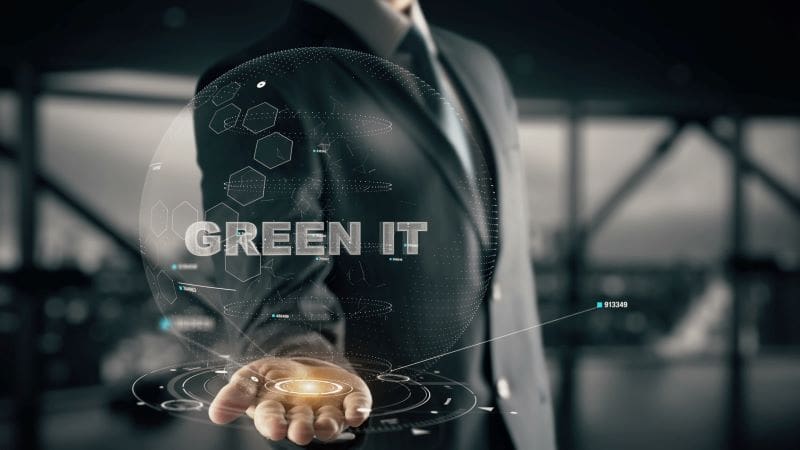Alan Alexeyev: Tell us about your current position and what you do?
Sumit Bhatia: I am a global infrastructure solutions architect with more than 15 years of experience in the industry. I am working with one of the largest oil field services (OFS) companies in the world. My focus is around addressing the difficult business challenges and encouraging Green IT through my deep knowledge with Hybrid cloud technologies, employing automation tactics and solutions engineering.
Global warming and climate change have a significant influence on the way businesses operate today. Many companies have set high aims to become carbon neutral by 2050. This is especially crucial for firms that operate in the energy sector. This is because major actors in the energy industry must be responsible and mindful of sustainability to remain in business.
When enterprises have such ambitious sustainability targets, it is necessary to look outside the box and push innovations aimed at conserving and optimizing energy use. IT is the backbone of any firm, allowing the sector to become more digital. And the IT division, like all other departments in a business, bears equal responsibility for achieving the greater goals of sustainability.
As you can see, this is a specialty focused subject in our business; so, as a global solutions architect, my purpose is to modernize IT processes with a focus on attaining sustainability and conservation in all we do.
AA: What is Green IT? Why is it important for the oil and gas industry?
SB: IT is the backbone that drives digitalization in any industry. It is commonly recognized, particularly in the oil and gas business, that information technology has boosted our industrial operations significantly. Primarily, advancements such as real-time monitoring of wellsite and rig operations, improving the drilling process, increasing yield, data collection and analysis to precisely predict operations, predictive maintenance of well sites, artificial intelligence, and so on are all examples of great IT contributions to the industry, enabling its existence and significantly contributing to where we are today.

Green IT is the modern discipline that focuses on developing and utilizing sustainable computing resources. By creating, solving, and using computer technology in an ecologically responsible way, it seeks to reduce the detrimental consequences of IT activities on the environment. The goal of Green IT is to maximize energy efficiency, optimize footprints so that desired activities have the least potential negative impact, and ensure that operations run better as well.
For the oil and gas industry, Green IT is especially important for two main reasons in my view:
- Given the oil and gas industry’s commitments to achieve Net Zero and reduce carbon emissions, this is only achievable if we include Green IT practices into our digital operations as well. It is only conceivable if we put less demand on our energy supplies and operate in the most efficient manner possible.
- According to recent news reports and studies, the energy business is experiencing its greatest downturn in history, which has also been exacerbated by the COVID-19 epidemic. All of this has led to corporations in the oil and gas industry reducing their budgets and annual spending. Since Green IT’s primary focus is on improving energy efficiency and optimizing IT footprints, it has helped enterprises to optimize their IT costs through clever innovations and smart hybrid cloud techniques. Simultaneously, make the needed IT processes even more performant and advanced as possible.
Thus, Green IT is the next level of advancements and again contributing sincerely to the modern objectives of the Oil and gas industry.
AA: How are sustainability and cost savings promoted when using Cloud platforms and automation in IT operations?
SB: The core of sustainability is preventing the depletion of our natural resources by preserving an ecological equilibrium. Respective strategies for harnessing the cloud and automating IT processes contribute to sustainability in diverse ways. For example:
- Key sustainability contributions with intelligent “Cloud platforms” adoption:
-
- Cloud platform providers such as Amazon, Google Cloud, and Microsoft, among others, offer chances to reduce waste and run just what is required through various services such as IaaS (Infrastructure as a Service), SaaS (Software as a Service), and so on. All of this is without considering CAPEX (capital expenditure). Furthermore, underlying hardware is shared across several enterprises using secure virtualization methods. As a result, we may completely avoid investments and unneeded hardware reservations when we execute activities in the cloud. As a result, using less hardware promotes sustainable IT operations and reduces energy use.
-
-
-
- These cloud platform data center providers are progressively opening locations throughout the world that run on power supplied from green and renewable sources rather than fossil fuels. A big contribution to sustainability.
-
- Key sustainability contributions with “Automation in IT operations”:
-
- The automation tools allow “Just in Time” IT operations possible meaning the underlying hardware technology is involved only when it is needed. Thus, conserving the energy in IT operations.
- Automation increases the hosting density of a single hardware platform since it runs only when necessary. This results in a large reduction in the number of hardware assets required to conduct operations. This leads in lower energy use and less silicon to recycle.
- When manual operations are automated, it saves productive man hours that would otherwise be squandered on recurring tasks. This adds to the cost savings.
-
We have opportunities everywhere. With proper harnessing of some of these opportunities provided in the right manner, we can ensure to meet our sustainability objectives in digital operations.
AA: Tell us more about your contributions to the industry towards promoting Green IT and cost savings.
SB: Over the last 15 years, I’ve had the opportunity to work with some of the specialized industry groups driving technological innovation. I got a chance to contribute to different breakthrough innovations. I can list a couple of them below:
- Introduced Capacity Management as a Service (CMaaS) process using Turbonomic, an IBM product, to optimize cloud workloads through self-service for end users. This guarantees that workloads running in the cloud are appropriately scaled, preventing resource overallocation and lowering operating costs. At the same time, ensuring that the appropriate number of resources are assigned to cloud workloads that are underutilized while maintaining the acceptable level of performance. This approach has a substantial influence on not only lowering the operating costs of cloud workloads but also on energy conservation by increasing the hosting density of cloud platforms. This ensures that the latest cloud technologies are used optimally for our advantage.
- Implemented smart backup technology, which is based on the concept of “forever incremental” with Hitachi’s renowned backup product. This is especially important for promoting Green IT because:
-
- Only incremental data is stored in the storage repository for backups instead of full data replicas in traditional solutions. Less storage means reduced IT footprints and consequently lesser IT operations costs for the customers.
- It enabled the use of public cloud storage space for hosting the backup data because customers must pay very minimal charges for ingress/egress traffic. Thus, it further allows the reduction of infrastructure assets and promotes sustainability in IT operations.
- Finally, I’d like to highlight my latest book publishing, “Reverse Engineering with Terraform.” This encourages the use of IaC (Infrastructure as a Code) technology and complete automation of IT processes. IaC adoption enhances hosting density while reducing the number of hardware components in IT infrastructure. Reduced hardware reduces energy usage and yields less silicon for recycling. Furthermore, full automation decreases the number of man hours necessary to run the platform, resulting in lower investment costs.
AA: Do you want to talk about the recent international book you published, “Reverse Engineering with Terraform”?
SB: My recent book, “Reverse Engineering with Terraform: An Introduction to Infrastructure Automation, Integration, and Scalability using Terraform,” was published by renowned technology book publisher Apress and is accessible globally on almost all major bookselling platforms. This book gives a practical approach to using Terraform IaC in the real world with both legacy and current IT systems. I demonstrated in the book that using reverse engineering principles allows Terraform to integrate with pre-existing resources, allowing for full-fledged automation with various IT infrastructure technologies. This book will give academic guidance to many automation enthusiasts in our sector.
AA: How is your book contributing to the industry?
SB: I recognized the importance of IaC in the digital sector. IT infrastructure technologies have long been in need of a single solution that could improve not just administration but also utilization efficiency. Terraform is an IaC tool that integrates with a wide range of technologies in IT infrastructure and can attractively abstract the underlying heterogeneous infrastructure technologies across a large spectrum of infrastructure domains. However, the implementation of Terraform is not straightforward and simple since, with pre-existing resources, the Terraform tool has severe limitations. Anyone may now use Terraform in infrastructure automation to its full potential by following reverse engineering principles, as I detailed in the book. This book and the reverse engineering technique I developed may now be used by many automation enthusiasts in our sector. The reverse engineering approach will be used in a variety of deployments since it has the potential to save businesses considerable money while also boosting IT efficiency. Consider how historical IT solutions used in oil and gas operations may be modernized without needing large infrastructure modifications, allowing them to embrace contemporary IaC automation approaches.
AA: How do you see IT technology evolving in the oil and gas industry?
SB: As I previously stated, IT has played an important part in the digitization of our sector and the simplification of a number of oil and gas processes that were once unattainable for many in our industry. With today’s challenges in our sector, such as sustainability and energy transition, I believe that digital technology will once again play a critical role. In our field, experts properly state that “data is the new oil.” With the correct collection of digital technologies, such as artificial intelligence, machine learning, DevOps, cloud computing, and so on, our industry’s current challenges have a greater chance of being met than ever before.
AA: What inspires you the most?
SB: I consider myself fortunate to work in the energy industry, where I have the opportunity to make a worldwide influence while also participating in the energy transformation journey. Knowing the fact that about 70% of all carbon emissions globally are energy related. I feel motivated when I play my part through my contributions in Green IT and solutions engineering. This is, in a way, my small dime into the larger contributions that are happening in our industry to decarbonize our planet and make it more sustainable so that we are providing a better world for our future generations to come.
AA: Any message you like to give to young professionals aspiring to join the Energy industry?
SB: Our industry is facing a significant shift, and we are seeking new solutions to implement an energy transition. The industry needs more young players that can understand the modern dynamics and present-day requirements of the energy industry. They challenge the legacy practices and finding innovative solutions to solve current day problems. There is no single mantra for success, but keeping yourself aware of the larger goals and always striving to do your best is the key.
Alan is a graduate from the University of North Dakota with a Master's degree in Petroleum Engineering. He previously earned his BA in Mathematics from the University of Houston and a BS in Petroleum Engineering from the University of Wyoming. Alan is an active SPE member and has presented at petroleum conferences and exhibitions.
Oil and gas operations are commonly found in remote locations far from company headquarters. Now, it's possible to monitor pump operations, collate and analyze seismic data, and track employees around the world from almost anywhere. Whether employees are in the office or in the field, the internet and related applications enable a greater multidirectional flow of information – and control – than ever before.









